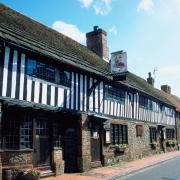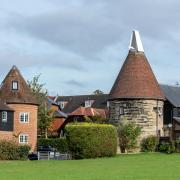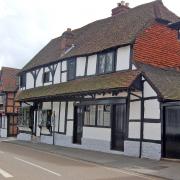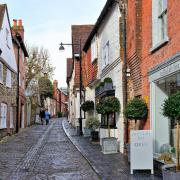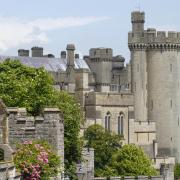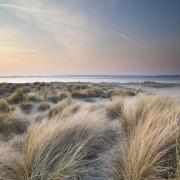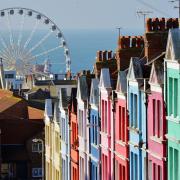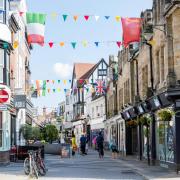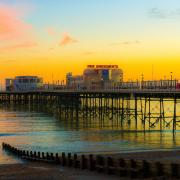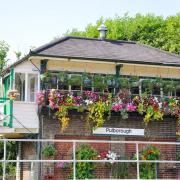A pair of puzzling 20th century mysteries originate from the East Sussex market town
Initial impressions can be deceptive. When visiting Uckfield you could be excused for concluding that it was a perfectly normal and pleasant former market town with a pretty river flowing through it. Nothing unusual here, you might mistakenly think.
But look behind the neat hedges, draw back the lace curtains and you may become aware of the curious fact that two of the most extraordinary episodes in this country’s history happened right here. Both not only puzzled our nation but also caused considerable consternation and confusion throughout the entire world.
Before unravelling any mysteries, I first have to find Brian Phillips of the Uckfield and District Preservations Society (UDPS). We meet at Bridge Cottage, a magnificent medieval Wealden hall house that dates from around 1436. When it was built isn’t a mystery thanks to dendrochronology, which uses the pattern of annual growth rings in wood to establish the date of timbers. Apparently the growth rings vary in width depending on the weather each year creating a pattern that can be matched to timber of a known age. Because buildings were constructed of green unseasoned timber they can reliably be dated to the year the timber was felled.
Although one of only a handful of surviving original properties, Bridge Cottage was in danger of being demolished in the early 1980s when the area behind it was redeveloped into a shopping complex. Thankfully, UDPS helped save it, restored it and now oversee its use as a splendid venue for a wide range of events.
We cross the 16th century bridge over the River Uck. Largely rebuilt in 1858, it has been battered down the ages by fairly frequent floods. Apart from bursting its banks, the river has given the council problems because of the ease with which signs bearing its name can be so easily vandalised by the addition of an unwanted ‘F’. The simple expedient of shortening the signs leaving no room at the front before the ‘U’ appears to have thwarted vulgar vandals.
There used to be a level-crossing by the bridge but this became something of a nuisance when the line south to Lewes was closed in 1969 leaving the station stranded on the wrong side of High Street causing traffic congestion whenever a train arrived or departed what was now the end of the line. A new station on the appropriate side opened in 1991 and the old station was demolished after sustaining what might appropriately be described as ‘terminal’ damage in the big flood that struck Uckfield on 7 October, 2000 when nearly six inches of rain fell overnight.
The offending river is looking remarkably peaceful as we climb up a hill and enter Victoria Pleasure Ground, a park that commemorates Queen Victoria’s Diamond Jubilee in 1897 and boasts, amongst other facilities, a croquet lawn. We are not here to knock balls through hoops but to admire a somewhat controversial horse trough unveiled in 1894 to commemorate the life of the Rev Edward Thomas Cardale, who was the first Rector of Uckfield when it became a parish in its own right in 1846. So what’s controversial about a horse trough?
Well, it would appear that the late reverend may have benefited financially from a plantation estate in Antigua that employed slaves. Although he didn’t make a lot from the enterprise or receive much in the way of compensation when it was stopped, it’s all a bit awkward in this day and age and probably explains why the trough doesn’t occupy a more prominent position.
Just up the road is another memorial but this time there is no embarrassment. In the grounds of the Highlands Inn stands an impressive plaque that commemorates the heroism of Flight Lieutenant Eugene Seghers, a Belgian pilot who was killed over Uckfield on 26 July 1944. Unveiled on the 70th anniversary of his death at a ceremony attended by many dignitaries, it records his extraordinary bravery in diverting a V1 (doodlebug) away from the town by tipping its wing. The V1 exploded when contact was made killing Seghers instantly and scattering the remains of his Spitfire in the vicinity of where the memorial stands today.
In rather more sombre mood, we stroll back downhill, cross the Uck again and wander around the northern side of town. Brian indicates a fine avenue of lime trees. A little while ago these trees were in urgent need of attention and, in what proved an excellent example of community action, ‘Lime Aid’ was formed to raise money and preserve them so that they are now in much better shape.
The trees once created an avenue at the entrance to Uckfield House, which was formerly the home of Lord and Lady Rupert Nevill. It was apparently where Princess Margaret was staying for the weekend with Group Captain Peter Townsend in October 1955 immediately prior to her announcement that she would not be marrying the former equerry. In what seems an extraordinary coincidence, it was also where she first met Anthony Armstrong-Jones, who was at Uckfield House to photograph the Nevills’ children. That meeting, of course, led to romance and marriage.
Sticking with the rather unorthodox behaviour of the upper classes, we cross to the west side of the High Street to where Grants Hill House once stood. Now demolished, the mansion was formerly the home of Ian and Susie Maxwell-Scott and the place where the notorious Lord Lucan was last seen alive. A friend of the Maxwell-Scotts, Lord Lucan drove there the night of 8 November 1974 after his children’s nanny was murdered.
His Ford Corsair was subsequently found in Newhaven but the poker-playing aristocrat was never seen again.
Although various theories have been put forward, his disappearance remains unexplained, whereas our final riddle was eventually solved. Again Uckfield was right at the heart of what has somewhat unhelpfully been described as a paleoanthropological hoax.
Back in 1912, Charles Dawson, an amateur archaeologist, claimed to have discovered the ‘missing link’ that evolutionarily connected apes with early man. A skull, said to be about 500,000 years old and to have been unearthed in a gravel pit in nearby Piltdown, grabbed headlines around the world. Christened ‘Eoanthropus Dawsoni’ (Dawson’s dawn-man) it caused a huge furore and doubts about its authenticity rippled down the decades until eventually in 1953 it was conclusively exposed as a forgery. Before he hit upon the idea of gluing bits of an orangutan to a human skull, Dawson, who lived in Lewes, was clerk to Uckfield Urban District Council and a founding partner of the Uckfield solicitors Dawson and Hart. We walk past their office in Church Street where a copy of the Piltdown Man skull is still stored, allegedly.
More…
• We went to find out more on the history of Rottingdean - Contraband goods provided a valuable source of income for Rottingdean in years past, and a number of illustrious figures have made it their home since then as Clive Agran discovers








